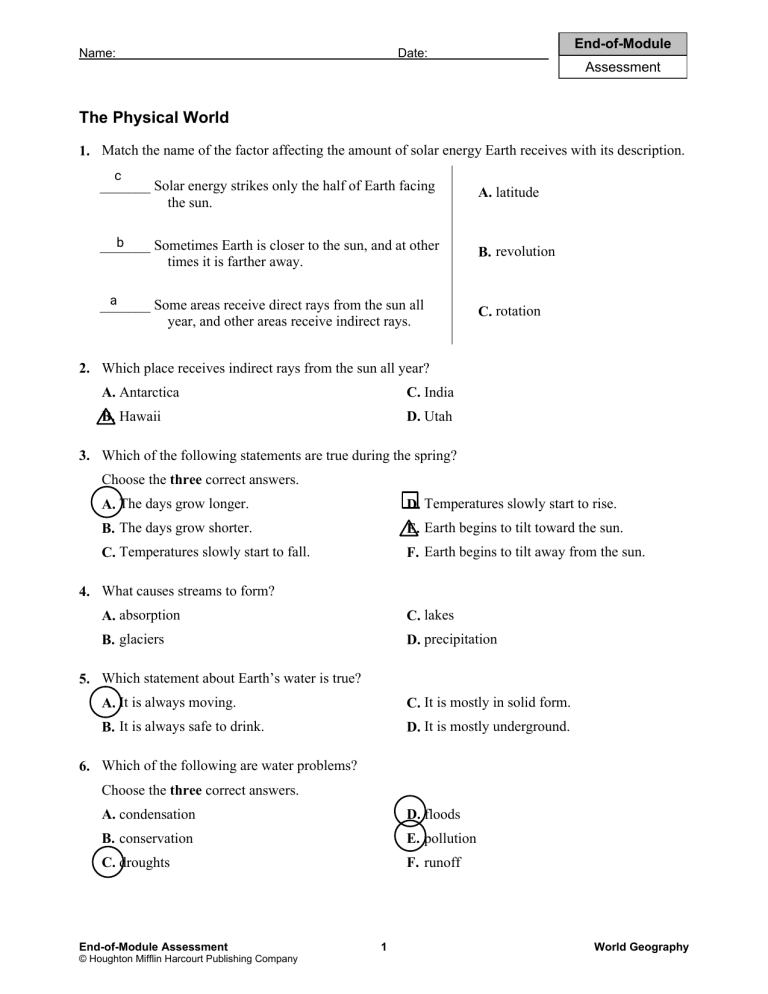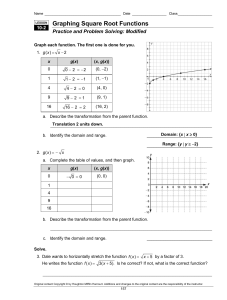
Name: End-of-Module Date: Assessment The Physical World 1. Match the name of the factor affecting the amount of solar energy Earth receives with its description. c _______ Solar energy strikes only the half of Earth facing the sun. A. latitude b _______ Sometimes Earth is closer to the sun, and at other times it is farther away. B. revolution a _______ Some areas receive direct rays from the sun all year, and other areas receive indirect rays. C. rotation 2. Which place receives indirect rays from the sun all year? A. Antarctica C. India B. Hawaii D. Utah 3. Which of the following statements are true during the spring? Choose the three correct answers. A. The days grow longer. D. Temperatures slowly start to rise. B. The days grow shorter. E. Earth begins to tilt toward the sun. C. Temperatures slowly start to fall. F. Earth begins to tilt away from the sun. 4. What causes streams to form? A. absorption C. lakes B. glaciers D. precipitation 5. Which statement about Earth’s water is true? A. It is always moving. C. It is mostly in solid form. B. It is always safe to drink. D. It is mostly underground. 6. Which of the following are water problems? Choose the three correct answers. A. condensation D. floods B. conservation E. pollution C. droughts F. runoff End-of-Module Assessment © Houghton Mifflin Harcourt Publishing Company 1 World Geography Name: End-of-Module Date: Assessment 7. Match the name of the landform with its description. c _______ a stretch of mostly flat land A. island a _______ an area of land completely surrounded by water B. peninsula b an area of land surrounded by water on _______ three sides C. plain 8. Write the letter of each tectonic plate in the correct location on the map. d a c b A. Indian plate B. Pacific plate C. Antarctic plate D. North American plate 9. Which of the following is the most common cause of erosion? A. ice C. water B. sediment D. wind End-of-Module Assessment © Houghton Mifflin Harcourt Publishing Company 2 World Geography Name: End-of-Module Date: Assessment 10. Which of the following affect the amount of sun that Earth receives at any given location? Choose the three correct answers. A. energy D. temperature B. movement E. tilt C. shape F. wind 11. Which of the following drives ocean currents? A. landforms C. storms B. seasons D. winds 12. Which of the following decreases with elevation? A. moisture C. temperature B. precipitation D. wind 13. Where do temperate climates occur? A. at low elevations C. in the high latitudes B. at high elevations D. in the middle latitudes 14. Match the name of the climate with its description. c _______ warm, muggy, and rainy year-round A. tropical savanna a _______ long, hot, dry season followed by short periods of rain B. humid tropical b _______ very little rainfall, high daytime temperatures and cool nights C. desert 15. Which of the following are characteristics of places that have the ice cap climate? Choose the three correct answers. A. They have no vegetation. D. They have very little precipitation. B. They have long summers. E. They have snow and ice year-round. C. They have absorbent soil. F. They have a wide range of temperatures. End-of-Module Assessment © Houghton Mifflin Harcourt Publishing Company 3 World Geography Name: End-of-Module Date: Assessment 16. Match the term with its description. c _______ the place where a plant or animal lives A. biome b _______ the land, water, climate, plants, and animals of an area B. environment a _______ made up of several ecosystems C. habitat 17. Why is it important to protect tropical rain forests? A. They contain valuable lumber. C. They contain the most biomes on Earth. B. They contain valuable farmland. D. They are the most varied habitats on Earth. 18. Which of the following would most likely increase soil fertility? A. a vegetable garden C. a decomposing tree B. a freshwater spring D. an animal population 19. Which of the following is a way to manage a renewable resource? A. mining coal C. conserving petroleum B. planting trees D. extracting natural gas 20. Which of the following is a harmful effect of hydroelectric power? A. air pollution C. water pollution B. lost farmland D. dangerous waste 21. Match the name of the mineral with the part of a building it is used to make. b A. quartz _______ steel beams c B. iron _______ exterior wall a C. granite _______ window glass End-of-Module Assessment © Houghton Mifflin Harcourt Publishing Company 4 World Geography

